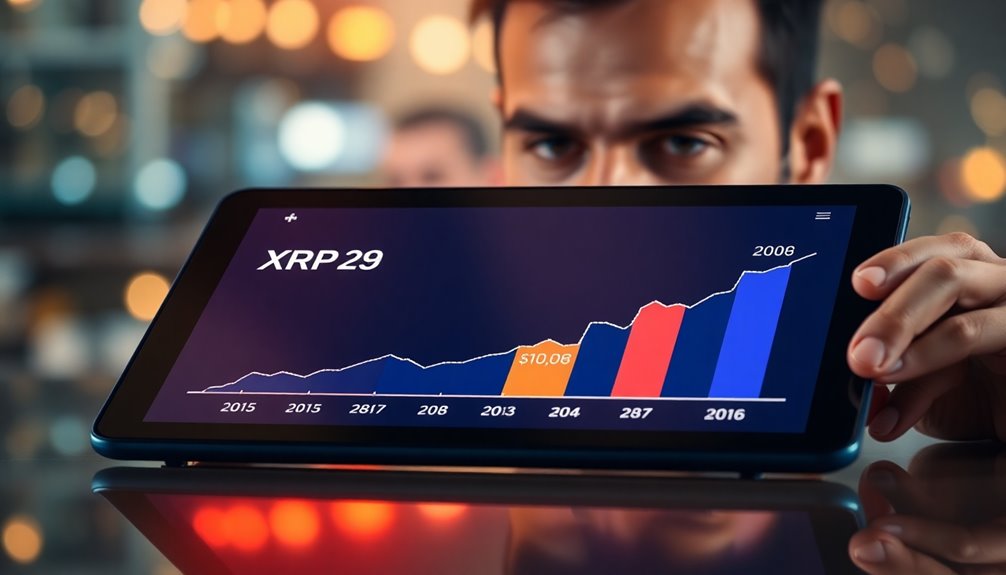XRP's recent surge to around $2 marks a key moment for its price trajectory. If it maintains momentum, projections suggest it might hit $5 by December 2024, requiring a 112% rally from its current level. Following that, reaching $10 hinges on Ripple's growth and regulatory adjustments. Analysts even see the possibility of hitting $20 long-term, driven by favorable market trends and investor confidence. The broader crypto adoption and Ripple's advancements will play significant roles in this journey. Curious about how these factors interact and influence XRP's price? There's plenty more to uncover.
Key Takeaways
- XRP is projected to reach $5 by December 2024, requiring a 112% increase from its current price of $2.494.
- Analysts suggest interim targets of $3.9993 and $5.5 before hitting $10, with regulatory outcomes influencing this timeline.
- Strong market sentiment and Ripple's expanding network could drive XRP to $10, supported by recent bullish momentum and increased investor confidence.
- Long-term projections indicate XRP may reach $20, fueled by historical trends and potential to replicate the 2017 bull run.
- Ongoing regulatory developments, especially regarding the SEC lawsuit, are critical factors that could accelerate or hinder XRP's price progression.
Current Price and Market Overview

As of now, the price of XRP stands at approximately $2.494 USD, reflecting recent market dynamics. You'll notice that XRP has seen notable fluctuations, with a recent high of $2.80 and a low of $2.17. The price briefly surged to $2.456 on December 16, 2024, showcasing its potential to swing significantly in a short time. The market sentiment is currently bullish, with a Fear & Greed Index score of 74, indicating a strong appetite for risk among investors.
In the last 30 days, XRP experienced 18 out of 30 green days, highlighting its upward momentum. The notable price volatility of 40.60% suggests that while the market is optimistic, you should stay cautious. Key support levels at $2.16 could provide stability, but if momentum falters, secondary support levels at $1.85 and $1.66 might come into play.
Recently, XRP's market cap remains significant, with a circulating supply of over 29 billion coins. This robust market presence, combined with recent legal developments, plays a crucial role in shaping XRP's price trajectory going forward. Notably, XRP has shown an impressive yearly change of +308.8%, indicating strong growth over the past year.
Short-Term Projections to $5

Could XRP really reach $5 by the end of December 2024? Predictions are optimistic, especially if XRP mirrors its impressive 2017 bull run. Analysts believe that if XRP can close above $2 this month, it could pave the way for a rise toward $5 by the end of 2024. However, it is important to note that cryptocurrency markets are notoriously volatile and can be influenced by a wide range of factors. Some investors and experts remain cautious, citing regulatory concerns and competition from other cryptocurrencies as potential barriers to XRP’s growth. An elite crypto insider recently cautioned that while a $5 XRP is achievable, it will require sustained positive developments and a favorable market environment. Therefore, it is essential for investors to carefully monitor the market and stay informed about the latest developments in order to make informed decisions about their XRP holdings.
However, you need to be aware that a significant 112% rally from the current price of $2.36 is required to hit that mark. One critical barrier is the psychological resistance at $3. Overcoming this level is crucial for a bullish trajectory.
Recently, XRP has experienced a 5.1% climb following the approval of the RLUSD stablecoin, which adds to the optimism. The formation of bullish patterns on the charts suggests a potential breakout, but the road isn't entirely smooth. Current price updates occur every 15 minutes for accuracy, which can influence short-term trading strategies.
Weekly active addresses are declining, indicating shifting investor interest. Keep an eye on market fluctuations, as they could play a role in your investment decisions.
With strong fundamentals and potential new partnerships, XRP might just surprise you on its journey to $5.
Mid-Term Projections to $10

The potential for XRP to reach $10 reflects a growing optimism among analysts and investors alike. Crypto analyst Dark Defender predicts it could hit $10, with interim targets of $3.9993 and $5.5 along the way.
InvestingHaven supports this view, citing Ripple's expanding network and the increasing adoption of its core assets. Meanwhile, Techopedia believes XRP could reach $10 by the end of the decade, highlighting upcoming price increases.
Regulatory influences also play a significant role. The nomination of Paul Atkins as the next SEC Chair could lead to a more favorable legal environment for Ripple, potentially resolving the ongoing SEC lawsuit. This scenario could substantially boost XRP’s price, as political shifts may bolster investor confidence in the market. Additionally, Ripple CEO’s latest interview highlighted the company’s commitment to working with regulators and building a positive relationship with government agencies. This approach could potentially result in a more favorable regulatory environment for XRP, further supporting the potential for price growth. Furthermore, if the SEC lawsuit is successfully resolved in Ripple’s favor, it could also pave the way for increased adoption and use of XRP in various industries.
XRP's recent bullish momentum, rallying over 200% in just a month, indicates strong market interest.
Furthermore, the community's involvement and strategic partnerships help drive XRP's growth. As more financial institutions adopt XRP for liquidity solutions, investor confidence grows.
With critical support levels established and a positive outlook in place, you're looking at an exciting mid-term trajectory toward the $10 mark for XRP in the near future.
Long-Term Projections to $20

Many analysts believe XRP has a solid chance of reaching $20 in the long term, driven by a combination of market trends and Ripple's strategic moves.
If XRP mirrors the 2017 bull run, it could easily hit $5 by December 2024. By January 2025, more optimistic predictions suggest it might even reach $30, although $20 remains a conservative target. Continuous learning and adaptation are crucial for investors navigating this volatile market.
Technical analysis supports these projections, with a bullish flag pattern indicating a rise toward $4.75 and potentially higher. As XRP approaches $2, it could pave a path to $8, setting the stage for a jump to $20 if favorable conditions persist. A close above $2 would indicate a 288% monthly increase, showing strong momentum for further gains.
Fibonacci levels also back this upward trajectory, showing possibilities for XRP to achieve $18 or even $20.
Furthermore, Ripple's increasing influence in the global payments arena and positive regulatory developments could significantly boost demand for XRP. The importance of financial management strategies cannot be overlooked as they will play a role in how investors approach these projections.
Institutional interest and market sentiment play a vital role in driving prices upward. With a projected minimum price of around $5.57 between 2030 and 2040, the potential for XRP to surpass $20 looks promising, especially as the crypto landscape evolves.
Factors Influencing Price Movements

Ripple's potential to reach $20 hinges not just on long-term projections but also on several key factors that influence price movements. One major factor is the regulatory environment. Ongoing legal battles with the SEC can create volatility, but favorable outcomes can significantly boost XRP's price. A clear regulatory framework enhances investor confidence, driving demand.
Market sentiment plays a crucial role too. Currently, a bullish outlook across the cryptocurrency market supports XRP's rise. Technical indicators show reduced volatility, indicating a potential breakout. However, mixed sentiments exist, with some investors optimistic about further gains while others caution against buyer exhaustion. The recent price action of XRP, currently above $1, signifies optimism from Ripple's legal battles and contributes to the market's bullish sentiment.
Global crypto adoption also impacts XRP's trajectory. As more people embrace cryptocurrencies, XRP may benefit from increased visibility and usage. Ripple's expanding market dominance further fuels speculation about its price potential.
Finally, technological advancements within Ripple's ecosystem are essential. The development of digital assets and smart contracts expands XRP's utility, while innovations in related technologies can enhance its appeal.
Frequently Asked Questions
What Are the Risks of Investing in XRP?
Investing in XRP carries several risks you should consider.
First, the centralization of validators and Ripple Labs' ownership could lead to market manipulation.
Regulatory uncertainties, especially the ongoing SEC lawsuit, add to the risk profile.
Additionally, XRP's price volatility hinges on market sentiment, which can shift rapidly.
Security challenges and the need for diversification are crucial for safeguarding your investment.
Always stay informed about regulatory changes that might impact your holdings.
How Do Technological Advancements Affect Xrp's Price?
Technological advancements significantly impact XRP's price.
When you see new features or improvements in the Ripple network, it often attracts more users, leading to increased demand.
Enhanced blockchain efficiency boosts adoption rates, while integrations with DeFi and NFTs give XRP more utility.
As Ripple's technology gains global traction, you'll likely notice a rise in XRP's price.
Staying informed about these advancements can help you make better investment decisions.
What Is the Significance of Ripple's Partnerships?
Ripple's partnerships are vital for its growth and adoption. When you see collaborations with major banks, it boosts trust in Ripple's solutions.
These partnerships streamline cross-border payments, making transactions faster and cheaper. By integrating XRP into established financial systems, you're witnessing increased efficiency and liquidity.
Moreover, these alliances enhance Ripple's credibility, attracting more businesses and developers, which drives innovation and strengthens its position in the competitive financial landscape.
How Does Market Sentiment Influence XRP?
Market sentiment plays a crucial role in influencing XRP's price.
When you see positive news or partnerships, it often boosts your confidence and encourages buying, driving the price up.
Conversely, negative news or regulatory uncertainties can create fear, leading you to sell or hesitate to invest.
The overall mood in the market, shaped by broader trends and Bitcoin's performance, directly impacts how you and other investors perceive XRP's potential.
What Role Do Global Regulations Play in Xrp's Future?
Global regulations play a crucial role in XRP's future. They create a stable environment that attracts investors, including institutions, by reducing risks.
With clear guidelines, you can expect lower compliance costs and streamlined operations for financial institutions. Favorable regulations in key regions can boost adoption rates, enhancing XRP's use in cross-border payments.
Conclusion
In conclusion, as Ripple (XRP) navigates its path from the recent $2 mark, you're looking at potential price milestones of $5, $10, and even $20 in the future. While short-term gains might seem enticing, keep an eye on the mid and long-term projections and the factors driving these movements. Staying informed will help you make the best decisions and maximize your investment opportunities as the market evolves.










